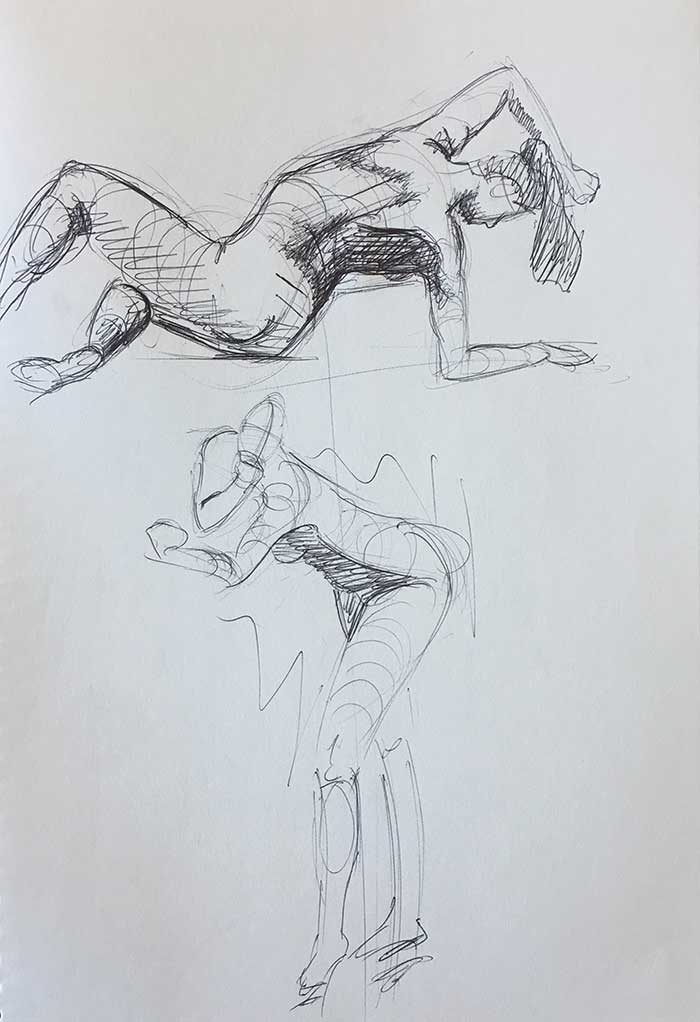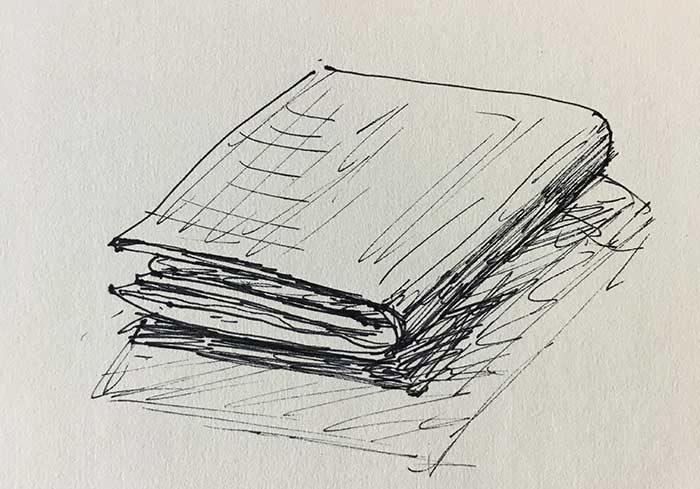If you want to improve your drawing skills, then I believe it is important that you put in regular practice (daily if possible). In a previous post, I wrote about how I was doing daily gesture drawings. I have continued with this practice and it has greatly improved my instinctive drawing skills and understanding of the human form.
In this post, I discuss some other simple drawing exercises which you can do every day, no matter what your skill level is. These exercises do not require much time or resources, but you will improve if you stick to doing them regularly.
These exercises can also be done with paint – the medium does not matter.
- Single Light Still Life
- All White / All Black
- Unusual Angle
- Zoom-In
- Upside-Down
- Negative Space Drawing
- Five Minute Burn
- Your Off Hand
- Your Feet
- Blind Contour
- Crumpled Paper
- Value Scales
- Summary
- Want to Learn More?
- Thanks for Reading!

Single Light Still Life
This is a classic drawing exercise that involves a simple still life setup illuminated by a single light source (usually a lamp as you can control the direction). Many of the exercises mentioned in this post are variations of the single light still life.
Here are some tips for this exercise:
- Use between 1-5 objects and experiment with the composition. Stick to fewer objects with simple shapes if you are just starting.
- Avoid using reflective or transparent objects (like glass) if you are just starting out, as these can be a challenge to render.
- When you have drawn the composition once, change the direction of the light and then draw it again. Repeat this process over and over, as this will give you a fantastic understanding of how light and shadow work.
- Set up your still life in the corner of the room so you can learn about reflected light.
- Keep the background simple.

All White / All Black
This exercise involves drawing an all-white object against an all-white background, or an all-black object against an all-black background. Because everything has the same local color, you will need to rely on subtle changes in value to indicate form.

Unusual Angle
Draw a standard object but from an unusual perspective. For example, draw a candle from directly above, or looking down at a sharp angle. This forces you to draw what you actually see, rather than what you think is there.
When we look at objects, we have preconceived ideas about what those objects are meant to look like. A common problem in drawing is letting these preconceived ideas influence what you draw, rather than drawing what is actually in front of you. These exercises will help train you out of this.

Zoom-In
Take a standard object and draw just part of the object up close. Try to focus on interesting parts of the object like intersections or edges. Once you are done, you could see if someone is able to identify what the object is from just your zoomed-in drawing.

Upside-Down
Take a reference photo of a standard object, turn it upside-down and draw it. I would start with a very basic object, like a vase or candle, then move on to more complex objects like a chair or even a person.
If you want to challenge yourself, you could even draw from life and flip the object in your head. Also, don’t worry about tone when you are just starting out. Focus on the contour of the object.

Negative Space Drawing
For a negative space drawing try to render the form of an object by only drawing the negative space (not the object itself).
For example, if you were doing a negative drawing of a chair, you would block in all the spaces which are not occupied by that chair. This exercise is designed at helping you learn how to appropriately use positive and negative space (negative space is frequently overlooked).
Five Minute Burn
This is one of my favorite drawing exercises. Give yourself 5 minutes and draw whatever is in front of you. Focus on capturing as much information as possible and do not get caught up in all the details.
The benefits of this exercise are:
- You don’t need to set anything up – you just draw what is there. It does not need to be pretty.
- It only takes 5 minutes plus some preparation time.
- It will train your instinctive skills.

Your Off Hand
Place your off hand (the one that is not drawing) in a comfortable position, then draw it. Start by resting your hand in a normal position on the table, then progress to more complex hand positions (clenched fist, open hand, etc).
This exercise is a great introduction to life drawing and it trains you to deal with slight movements of your hand and any distractions from your surroundings.
Tip: Break the hand into smaller shapes, then draw those shapes.

Your Feet
This is similar to the hand exercise. Look down and draw your own feet. I find this to be a great exercise for learning about foreshortening.
Again, try to break your feet down into basic shapes and draw those shapes. This helps you simplify the form and capture what is actually important.

Blind Contour
This is a classic exercise which trains your hand-eye coordination. Look at an object and try to draw it without looking down at your drawing. It is a lot harder than it sounds, so make sure you start with simple objects and only focus on the contour rather than tone.
Crumpled Paper
Drawing crumpled paper is a great way to learn about contours, edges and tones. Plus it is extremely easy to set up – just crumble some paper and draw it.
Value Scales
Draw your own value scale and aim to have an even jump between each value. The most common value scales have 3, 5 and 9 values. This is perhaps the most basic exercise, but it can be surprisingly challenging to get right.
To create your own value scale, draw a template on a piece of paper or canvas and fill in the values from pure black, to neutral gray, to pure white with equal value jumps in between. It does not matter if you do this with paint or pencil, as technique is not the focus of this exercise. The only thing that matters is how well you are able to render values.
I suggest that once you are done you compare your value scale to one you know is correct. I would be surprised if you are able to get all the values roughly accurate on your first attempt.

Summary
These exercises are not essential by any means. The purpose of this post is just to give you some ideas for exercises you can practice regularly which will improve your drawing ability over time.
But there is no substitute for just drawing regularly. The subject or type of exercise does not matter. Simple drawings like the ones below won’t win me any art awards but they help me constantly improve and provide me with inspiration for new ways to render subjects.


Want to Learn More?
You might be interested in my Painting Academy course. I’ll walk you through the time-tested fundamentals of painting. It’s perfect for absolute beginner to intermediate painters.
Thanks for Reading!
I appreciate you taking the time to read this post and I hope you found it helpful. Feel free to share it with friends.
Happy painting!
Dan Scott

Draw Paint Academy







This was great! I will certainly come back to it regularly. Thank you so much!
Glad to hear thanks Anita!
Hi Dan,
I really like your practical advice how to work with a single light when paint any object and how changing the angle of the light source affects the light and shadow of the subject. And also the idea of a constant practice of drawing any objects is very cool. I would like to start doing it someday.
Thanks Larissa
Thank you for these ideas, I would call myself a person with blocked creativity always postponing and making excuses of trying to produce some art, although ultimately this is my dream. I need to set myself a challenge to do one of these exercises a day and hopefully this will move something with me. Thank you for inspiration!
No problem thanks Kasia, Dan
Great and very helpful..keep up the good work
Thanks Neil!
Hi Dan, really enjoyed this one. Thanks for your regular posts. Am enjoying them. Carolyn
Thanks. I draw every day, even if it’s just quick doodles. I keep a sketchbook and drawing pencils in my purse so whenever I have to wait or have spare time I can draw. It has helped me develop better drawing skills. I would get less drawing time if I only waited to spend time in the studio. It was a very good article. Have enjoyed all the articles I have read.
So looking forward to trying each of these art adventures listed above!
Will you be posting additions challenges? Fun to try again and again.
Thanks for sharing art drawing/painting tips.
I am wanting to paint and I feel I do not know enough to do so. It is just so nice to be able to read what you have written and the drawings and paintings that you share. It gives me hope that I can learn to be a good artist.. Thank you
Thanks, just happy to be helping! Dan
Great practice ideas. I will definitely do more every day.
Sounds great Mabel! Dan
I enjoyed reading and will continue my progress through your literature am a self taught and you information if very well appreciated thank ypu and keep up the go work love to paint and want to become successful one day thank you
Starting today!
Wonderful Lisa! Good luck. Dan
Thank you for sharing drawing tips. Your posts about drawing were excellent. It will improve the drawings. Keep sharing more like this information. I have learned something new ideas from you. Your posts were very useful for me as a beginner. I love paintings, that’s why I have come here to read your posts. It’s really improved my knowledge of drawing. I’m sure that those exercises you told in your posts can make improvements in my paintings. Painting is almost everything. It is the painter’s style.
http://essaysauthor.com
Glad to hear the post and information is helping you with your drawings James! Thanks, Dan
Well, my first read article where all most valuable exercises are covered. Now I’m cosidering about getting your ebook.
Love this going to start tomorrow when I get home and make a promise to myself to do it every day thank you so much
The best time for me to begin serious painting was 10 years ago, the second best time is now. Thanks for the head start man!! Gotta unblock my creativity……
You have prepared an article as a guide. These are all great ideas.
potato
Bought my pencils and sketch book yesterday, did a bit more reading and then actually put pencil to paper for the first time since school. At 62 ! I’ve done the exercises to just get the feel of the pencil. Practiced drawing straight lines etc. then I drew a book that happened to be sitting on the tv unit. It looked like a book! Ridiculously pleased with myself I tried drawing what is in front of me. I think I went too far trying to add shading etc but it was recognisable at least. Best of all I know what I’ve done wrong and now I know where to find the answer ! Thank you so much for giving me the confidence to have a go !